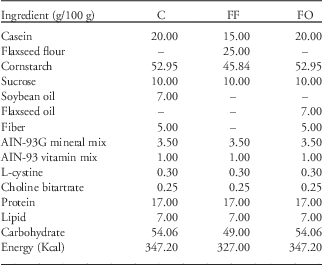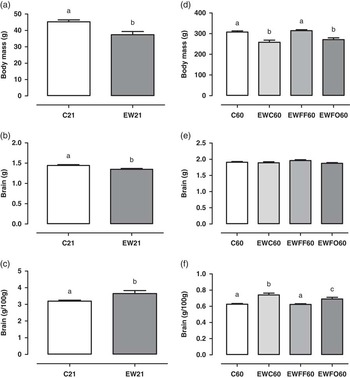Introduction
The last trimester of pregnancy through ⩾2 years post term is a relevant period for brain development, characterized by various processes such as neurogenesis and axonal and dendritic growth. A small disruption in any of the processes may bring about long-lasting effects on brain structure.Reference Belfort, Rifas-Shiman and Rich-Edwards 1 After birth, the infant’s exclusive source of nutrients is breast milk. The exact mechanisms that underlie the well-documented cognitive advantages associated with breastfeeding remain unclear. Lower duration of breastfeeding can be associated with thickness of the parietal cortex and general intelligence of adolescents born at term. Probably the essential fatty acids prevalent in breast milk improve the white matter structure and cognitive performance.Reference Kafouri, Kramer and Leonard 2 , Reference Deoni, Dean and Piryatinsky 3
Among all oleaginous substances, flaxseed contains the largest amount of essential fatty acids. Previously, our group reported on the essential fatty acids produced by flaxseed in the early period of life that are fundamental for brain development.Reference Almeida, Boavetura and Guzmán-Silva 4 , Reference Meneses, Lopes, Velarde and Boaventura 5 However, there are no reports in the literature about brain development in rats subjected to early weaning and that were treated with a diet containing flour or flaxseed oil after 21 days until 60 days.
Materials and methods
The protocol used to deal with experimental animals was approved by the Ethics Committee on Animal Research of Fluminense Federal University, Niteroi-RJ, Brazil (protocol 597/2014). All procedures were in accordance with the provisions of the Brazilian Society of Laboratory Animal Science and the Guide for the Care and Use of Laboratory Animals.
Wistar rats were kept in a temperature-controlled room (23±1°C) with an artificial dark–light cycle (lights on from 7 am to 7 pm). Virgin female rats (3 months old) were caged with male rats, and after mating each female was placed in an individual cage with free access to water and standard laboratory food (Nuvilab®, Paraná, Brazil).
Within 24 h of birth, excess pups were removed, and only six male pups were kept per dam. This procedure maximizes lactation performance.Reference Fishbeck and Rasmussen 6 During the lactation period the dams were fed a control diet containing 7 g of soybean oil and 20 g of casein/100 g, in agreement with American Institute of Nutrition (AIN-93G) recommendations.Reference Reeves 7 The pups from the control group (C, n=15) were separated from the mother on the 21st postnatal day. The pups in the early weaning group (EW, n=37) were separated from their mothers on the 14th postnatal day. The pups were maintained until day 21; however, the free access to water and control diet was not evaluated. After separation from their mothers, the rats from C and EW groups were maintained together in their original cage (up to six pups per cage).
At 21 days, the body mass of six rats of the control (C21, n=6) and six rats of the EW (EW21, n=6) group was evaluated. They were then anesthetized with Thiopentax® (Sodium thiopental, 0.1 mg/100 g) and euthanized by exsanguination. The brain were dissected and weighed. Masses were expressed as absolute (g) and relative (g/100 g) mass (adjusted to body mass).
After 21 days, the remaining control animals (C60, n=9) were fed a control diet containing 7 g of soybean oil and 20 g of casein/100 g. The remaining EW animals were divided into three groups: EW fed a control diet (EWC60, n=10); EW fed a diet containing 25 g flaxseed flour and 15 g of casein/100 g (EWFF60, n=11); and EW fed a diet containing 7 g flaxseed oil and 20 g of casein/100 g (EWFO60, n=10). The 25 g/100 g of flaxseed flour aimed to meet the entire recommended fiber intake and it was not necessary to add oil because this seed is a source of this component (Table 1). Food intake (g) was evaluated weekly. After 39 days of treatment, at 60 days, the C60, EWC60, EWFF60 and EWFO60 groups were euthanized and evaluated as described for the C21 and EW21 animals.
Table 1 Composition of experimental diets

C, control diet; FF, flaxseed flour; FO, flaxseed oil; AIN, American Institute of Nutrition.
FF and FO experimental diets containing 25 g/100 g of flaxseed flour or 7 g/100 g of flaxseed oil, respectively. Casein, mineral and vitamin mix, L-cystine and choline bitartrate: Pragsoluções®; cornstarch and fiber: FARMOS®; soybean: Liza®; commercial sucrose: União®; flaxseed flour: Armazen® with 17% of protein, 45% of carbohydrate and 26% of fat; flaxseed oil: Giroil Agroindustria® with 3.66 g α-linolenic acid and 0.86 g linoleic acid for each 7 g.
Formulated on recommendations of the AIN-93G for rodent diets.
Statistical analyses were carried out using the Graph Pad Prism statistical package version 5.0, 2007 (San Diego, CA, USA). The results at 21 days were analyzed by Student’s t-test. The remaining results were analyzed using one-way analysis of variance, followed by Newman–Keuls post-test, and expressed as means±s.e.m., with significance level of 0.05.
Results
At 21 days, the experimental group showed lower body mass (P<0.05, EW21: 37.42±1.97 v. C21: 45.25±1.21 g) and absolute brain mass (P<0.05, EW21: 1.34±0.01 v. 1.44±0.02 g). The relative brain mass was higher (P<0.05, EW21: 3.64±0.17 v. C21: 3.19±0.05 g/100 g) (Figs. 1a, 1b and 1c).

Figure 1 Body mass (a and d), and absolute (b and e) and relative (c and f) brain mass at 21 and 60 days, respectively. C21 and EW21 groups analyzed at 21 days. C60 and EWC60 groups treated with control diet. EWFF60 and EWFO60 treated with diet containing 25 g/100 g flaxseed flour or 7 g/100 g flaxseed oil, respectively, and analyzed at 60 days. a,b,cValues with different superscripts are significantly (P<0.05) different (a, b and c Student’s t-test; d, e and f one-way ANOVA, followed by Newman–Keuls post-test). C, control; EW, early weaning; EWFF, early weaning flaxseed flour; EWFO, early weaning flaxseed oil, EWC, early weaning control; ANOVA, analysis of variance.
The food intake during nutritional treatment was similar between groups (C60: 106.60±19.99; EWC60: 87.35±16.53; EWFF60: 97.95±17.64; EWFO60: 95.05±16.39 g). At 60 days, the EWC60 (258.00±10.11 g) and EWFO60 (271.20±8.62 g) groups showed lower (P<0.05) body mass when compared with C60 (308.10±5.29 g) and EWFF60 (314.70±4.31 g) groups. The absolute brain mass was similar between groups (C60: 1.91±0.01; EWC60: 1.89±0.03; EWFF60: 1.96±0.02 and EWFO60: 1.87±0.02 g). With regard to relative brain mass, C60 (0.62±0.00 g/100 g) and EWFF60 (0.62±0.00 g/100 g) were similar. EWC60 (0.74±0.02 g/100 g) had higher brain mass (P<0.05) when compared with the other groups. EWFO60 (0.69±0.02 g/100 g) had lower values (P<0.05) when compared with EWC60, and higher (P<0.05) compared with C60 and EWFF60 (Figs. 1d, 1e and 1f).
Discussion
The American Academy of Pediatrics believes that infant nutrition should not be considered merely as a lifestyle choice but as a public health issue.Reference McInerny 8 Herba et al. Reference Herba, Roza and Govaert 9 and Kafouri et al. Reference Kafouri, Kramer and Leonard 2 reported a positive impact of breastfeeding on mature brain development in infants and improved cognitive performance in adolescents. In the present study, the rats subjected to EW showed lower brain mass at 21 days. The outcomes observed in the relative brain mass of young rats treated with flour or flaxseed oil suggests an impact of shorter breastfeeding.
Substantial structural and functional development occurs in the brain between birth and 1 year of age and this involves accumulation of fatty acids.Reference Innis 10 The essential polyunsaturated linoleic acid (LA) and α-linolenic acid (ALA) are important for brain growth and maturation. Animal studies showed that deficiency in ALA during early postnatal periods could affect cognitive development.Reference Bernard, Agostini and Forhan 11 At 14 days of life, rats begin consumption of solid food. At this age, pups still breastfeed, but they can survive independently of their mothers.Reference Oliveira, Silva and Silva 12 However, the precocious interruption of lactation can be a prime factor for behavioral changes, such as higher anxiety, higher motor activity and reduced cognitive performance, which exhibit significant sex dependence.Reference Younes-Rapozo, de Moura and Lima 13 – Reference Stratton, Staros and Budefeld 15 A limitation of the present study is the fact that we could not evaluate behavior and sex differences in relation to brain development. Even so, the lack of calories and fatty acids derived from milk was not offset by solid food, with repercussions on lower body and brain mass in the EW group at 21 days.
The EW rats showed higher relative brain mass, which led to the conception of brain ‘sparing.’Reference Freedman, Samuels and Fish 16 After a complicated pregnancy, the fetal cardiac output is redistributed, shunting blood flow away from the peripheral bed and toward essential vascular beds, such as those perfusing the brain. Thus, the baby has an increased head diameter to body length or weight ratio, with a reduced ponderal index, being thin for its length.Reference Giussani 17 Babies in lower socioeconomic groups have sustained degrees of prenatal nutritional deprivation, usually followed by continuous malnutrition until early adolescence, which can disrupt certain basic developmental and organizational features, resulting in alterations in plasticity.Reference Morgane, Austin-Lafrance and Bronzino 18 In this context, the EWC60 showed higher relative brain mass at 60 days, which was not observed in the EW animal treated with a diet containing flour or oil of flaxseed.
The period of 21–60 days was characterized as the recovery phase, with the purpose being to stimulate the catch-up effect, considered a physiological adaptation that allows man and animals to return to their genetically programmed growth trajectory after a period of growth retardation.Reference Costa, Alves and Gonzalez 19 Contrarily, the catch-up phenomenon has been associated with the programming of obesity, after early malnutrition,Reference Bieswal, Ahn and Reusens 20 characterized by the presence of hyperphagia.Reference Lima, de Moura and Passos 21 During the recovery phase, the groups showed similar food intake. Although the experimental diets contained similar amounts of protein and lipids, the EWFF60 group showed recovery from malnutrition, whereas the EWFO60 animals showed brain sparing at 60 days. Flaxseed oil contains 52% of ALA and 12% of LA, whereas flaxseed flour contains lipids (50–55% of ALA and 15–18% of LA), fibers, protein, minerals and carbohydrates distributed among phenolic acids, sugars, lignin and hemicelluloses.Reference Ribeiro, Silva and Pereira 22 Probably the composition of flaxseed flour contributes to a greater biological utilization of nutrients and energy to body and brain growth. Malnourished babies are likely to exhibit marginal development; they are less capable of adaptive functioning in the face of adversity or stress, with reduction in flexibility and range of behavior.Reference Morgane, Austin-Lafrance and Bronzino 18 Despite preliminary analysis, these results indicated that flaxseed flour, in comparison with flaxseed oil, contributes to brain development after EW. Further studies are necessary to measure the effects of flaxseed in brain physiology and behavior in rats subjected to precocious interruption of lactation.
Acknowledgments
The authors are thankful to Coordination for the Enhancement of Higher Education Personnel (CAPES) and to the National Counsel of Technological and Scientific Development (CNPq).
Financial Support
This work was supported by The State of Rio de Janeiro Carlos Chagas Filho Research Foundation (FAPERJ) (number process 103373/2012 and 477763/2011).
Conflicts of Interest
None.
Ethical Standards
The protocol used to deal with experimental animals was approved by the Ethics Committee on Animal Research of Fluminense Federal University, Niteroi-RJ, Brazil (protocol 597/2014). All procedures are in accordance with the provisions of Brazilian Society of Laboratory Animal Science and the Guide for the Care and Use of Laboratory Animals.





